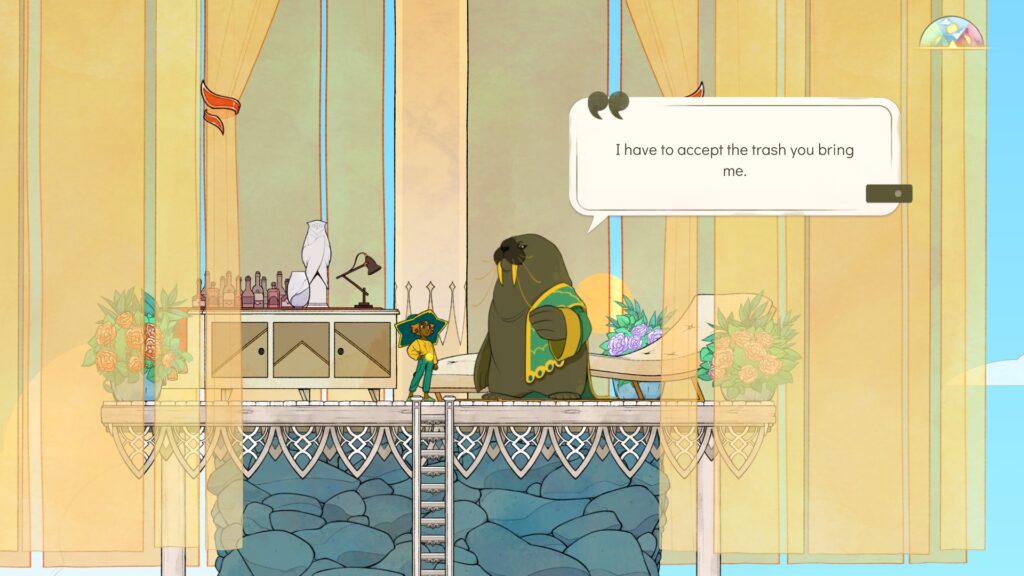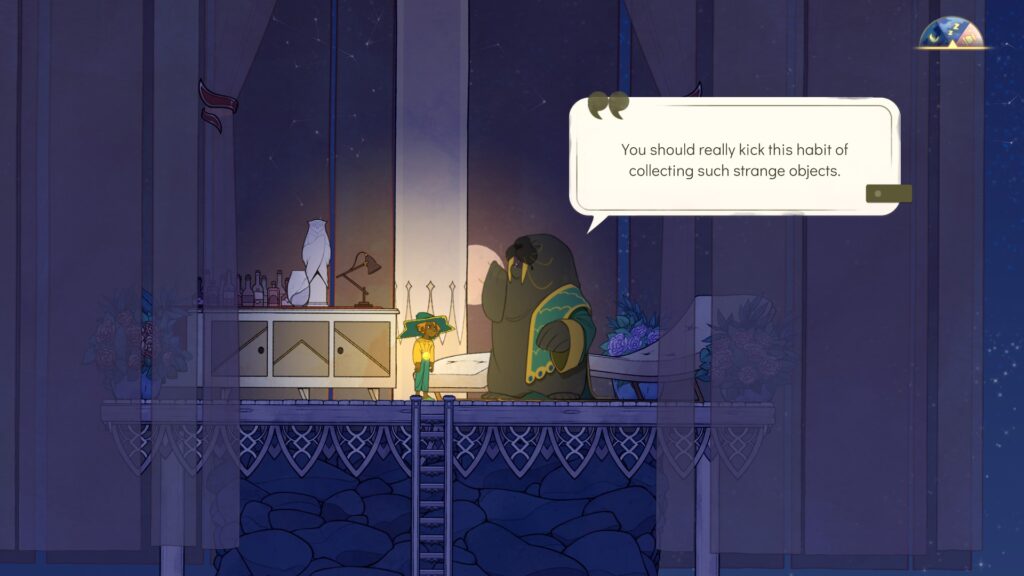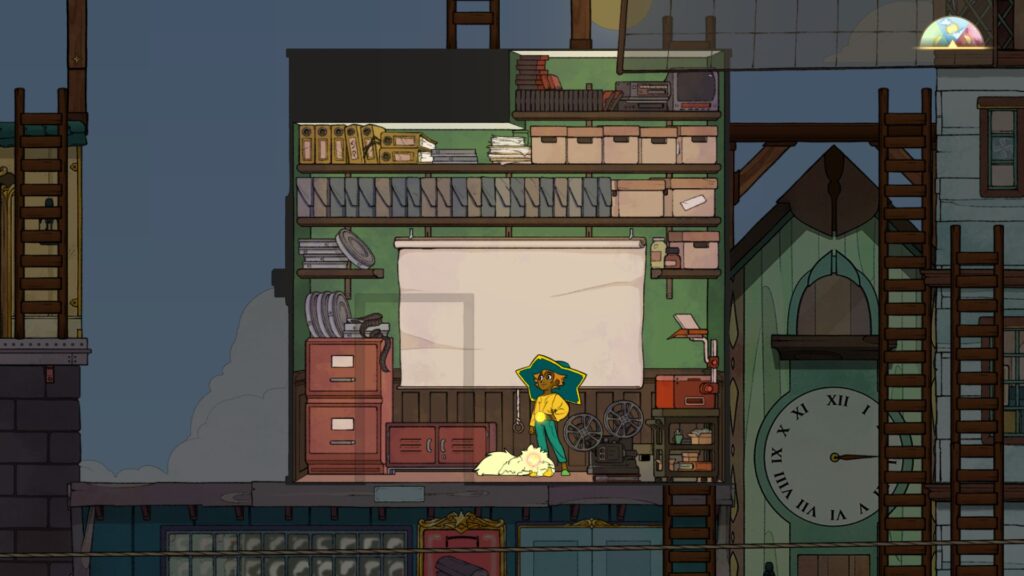There is a character in Spiritfarer called the Collector, a well-dressed, finicky walrus who goes by the name of Susan. When the player first meets Susan, she describes her distaste for the collection of “junk.” Nonetheless, Susan is the in-game collections achievement tracker, and will reward the player for finding objects throughout the game. While Susan is a minor character in-game, “collection management” is a real-world profession integral to museums, libraries and other curatorial institutions of all themes and sizes. This post will discuss Susan’s role and her views on collecting, and compare Susan and her ideas to real-world institutional collection management practices. In comparing real-world collection practices with those in Spiritfarer, I hope to show how Spiritfarer’s “reconstructive” storytelling and its collection mechanics can help shed light on the memory function of collection management policies and practices of libraries and museums.

The Game
Created by Thunder Lotus in 2020, Spiritfarer is a 2D side-scrolling action-platformer and lore-rich adventure game, also pitched as “cozy management game about dying.” The game’s protagonist, Stella the spiritfarer (or ferrymaster), goes around the magical and charming world on her ever-expanding boat, befriending and caring for spirits until they’re ready to move on to the afterlife. In an interview, the studio staff describe their inspirations for the game’s setting and gameplay, which include Greek mythology, Studio Ghibli’s Spirited Away, and farming simulators such a Harvest Moon and Stardew Valley. The game’s easy pace, detailed animation, and beautiful music come together to unravel touching stories that explore death and compassion.
In terms of gameplay, Stella (the player) manages her boat by travelling from island to island, collecting materials which she uses to build structures, make items, and upgrade the vessel. Stella has a bottomless inventory, and everything from wooden planks to bottled ectoplasm will be kept until the items are used or sold. As Stella meets spirits on her journey from island to island, the spirits join Stella on her boat as a passenger. They request structures (like a kitchen or gallery) or food, which the player crafts. Spirits will also ask for quest-specific items, and Stella is often sent across the map to find knick-knacks in boxes, on top of buildings, and even in the middle of the sea. The quests, which drive the stories pertaining to the spirits, lead Stella to numerous islands, including one called Susan’s Museum.

Susan’s Museum
Susan’s Museum is an island in the North West part of the world in a region called Hummingberg. When Stella arrives at the island, she goes up an elegant white ladder which leads to a single platform. The tiny one-person island is an elegant lounge for the NPC who lives there, and there isn’t anything or anyone for the player to interact with, except Susan.
Susan is the Collector. Susan is a walrus (many NPCs are animals), and her introduction dialogue reveals a lot about her personality, as well as her opinion about the act of collecting. Stella never speaks, so Susan has a one-way introductory “conversation”. Her monologue is as follows (shortened for length):
… The gods, in all their materialistic arrogance, have played a cruel trick on me.
You see, I am the Collector not by choice, but by duty.
Through your ceaseless plunder of this world’s very finite wonders, you will no doubt come to stockpile a collection of junk to rival the greatest garbage dumps of history.
My duty is to “reward” this unconscionable behavior with, well, more junk.
My predecessors used to ask for the accumulated bundles as payment, to do who knows what with.
But the job description says nothing about that, and I certainly have no interest in your filth.
So when the time comes, show me what monstrous assortments you managed to pull together, grab your meaningless reward, and leave.
In Spiritfarer’s gameplay, Susan functions as a collection achievement tracker. The Spiritfarer Art Book states, “In a game filled with objectives, gathering and building mechanics, Susan the walrus’ primary purpose is to deter Stella from collecting the unnecessary. What she considers unnecessary, however, is… a lot of things.” Thus, every time Stella visits Susan, the player can see the figurines, sea creatures, gems, metals/ores, and dishes (as in cooked dishes) the player has collected. Some of these items are crafting materials (or are crafted items), while some items are knick-knacks (such as figurines) that can be sold for in-game currency. As Susan describes, each time the player reaches a collection milestone, the player receives an award.

Collection Development
Susan the walrus’s role as the Collector exists in real life. There are private collectors in the world at large, but the roles I’m most familiar with are librarians and archivists, who often hold some responsibilities related to collecting (and often also curating) for an institution. Just the way Susan is concerned about people collecting “junk,” real-world professionals are also mindful of what they collect for their institution. To establish some rules about what to collect (or not), these professionals often use a “collections development policy.”
A collections development policy (or management policy, or selection policy, you get the idea) is like a “rulebook” for institutions that engage in collection and curatorial practices. A public library, university, museum, or even government institution will use such a framework to determine whether potential objects fall within the scope of their mandate. Unfortunately for Susan, Stella’s relentless habit of collecting is her scope, which can seem pretty arbitrary.
In addition to considering what is useful and not useful for taking in, a collections management policy also helps determine when some item should be retired. Some institutions call that “deaccession,” other calls this “weeding.” Libraries do it, and so do museums. In Spiritfarer, there are items called “tchotchke” (miscellaneous items) and their descriptions say “Should be sold.” They have no other value. When the player sells these items, that’s sort of like weeding.
Imagine a bookshelf with ten books. Now imagine a bookshelf with a hundred books. If you’re looking for one title, the bookshelf with ten books would be easier to search through. But, the bookshelf of one hundred books has a higher chance of having the title you’re looking for. Do institutions keep a smaller collection to make search more manageable, or manage a robust collection to ensure they can fulfill patron requests? These determinations are (part of) the job of the librarians and archivists.
Susan considers a lot of items as “junk.” “Junk” and “garbage” might be harsh words, but professionals also must consider the value of a given book or object in a collection of curated items. Sometimes books get damaged (missing pages, moldy, etc.), and are no longer useful or safe for patrons. Sometimes books become outdated when new editions are published. Sometimes the best thing to do for everyone is to remove the book in question from circulation, and either archive a legacy copy or sell superfluous books in library sales (or, if the book is literally in tatters, recycle it).
Back to Susan the walrus. She mentions payment, “My predecessors used to ask for the accumulated bundles as payment, to do who knows what with. But the job description says nothing about that, and I certainly have no interest in your filth.” Susan’s function is unique in that she merely looks at what you have in your inventory, then rewards you. In most games, like in Stardew Valley, the museum usually keeps the in-game item. In real-world situations, the books or objects are obviously given or loaned to the institution.
Susan also mentioned rewards: “My duty is to ‘reward’ this unconscionable behavior with, well, more junk.” Curatorial institutions do not typically reward patrons for the process of collecting. If anything, previous acquisition processes have come under scrutiny because of unscrupulous methods of artifact collection; museums are now careful about stolen or looted objects (as briefly mentioned in the Museum in Animal Crossing). On the flip side, the history and uses of an object is often what makes it valuable, so collecting objects of value can be a double-edged sword!
Do institutions reward people who donate or sell stuff to them? Well, some institutions buy stuff, so the seller gets money. New York Public Library had acquired some books for their performing arts branch in 2020, noting that the process was reduced “for financial and physical reasons” but nonetheless indicates that market transactions can be part of curatorial policies and practices.
A common practice for curatorial institutions is to receive collection items by donation. Reviewing donations is a thorough process. If items are selected for inclusion in a collection or exhibit, donors might be “rewarded” with their name on a museum label. But “reward” could be something beyond money, a certificate, or wall plaque. For some, donating to an institution means their family or personal story gets preserved. In Spiritfarer, the whole point of the game is to learn and acknowledge stories of people’s lives. To have someone see, hear, or read your story, to know it will be kept safe for your family, community, and future observers, that may be a reward in and of itself.
So what does Susan give Stella when she shows up with a full roster of fish, figurines, metals, gems, or cooked dishes? Susan will reward the player with more materials, a few tchotchke, a handful of structure blueprints, or the occasional character customizable outfit. Yes, Susan does complain about it the whole time. Rather than actual preservation and collections management (since Susan doesn’t keep anything, display anything, or provide plot-essential rewards), Susan’s purpose, design, and script seem more about creating a memorable character and sending a message, rather than serving any significant function in the game.
Art Collector and Curator
I hesitated to use the term “curator” throughout this piece to describe the player or Susan, because there’s actually a “curator” character in Spiritfarer named Gustav. Gustav is a tall brown and red owl, and he is one of the spirits Stella helps usher onto the afterlife. When he was alive, he was an art curator and event organizer. Unlike Susan, who is a static resource NPC on her island, Gustav has a robust storyline — the player actually meets Gustav first, who sends Stella to Susan’s Museum in search of “traditional woodprints” to complete his collection. In Spiritfarer, Susan and Gustav are set up as opposing personalities. Susan had obtained the woodprints first and refused to sell them to Gustav. The Spiritfarer Art Book states, “Her character is to be Gustav’s foil in his quest to curate rare authentic pieces of art. She does not care to understand the reasons for what she sees as futile, and will snidely hide away any piece coveted by Gustav if she manages to get her hands on it first.”
Like Susan, Gustav has some strong opinions about his work. During his dialogues, he gets very offended that “some no-good, foul-mouthed miscreant just had the audacity to call me… I can’t even say it… an art collector!… I am a CURATOR!” Gustav goes on to describe the differences between art collectors and curators: “I do not amass, evaluate, weigh or risk! I do not trade! I protect! I alone ensure the legacy of humanity’s greatest achievements! What? Overreacting? Have you gone mad?”
I don’t speak for art collectors or curators, but archivists and librarians can and sometimes do see themselves as protectors of their collections who “ensure the legacy of humanity’s greatest achievements.” And they do it in the way Gustav describes. Archivists and librarians amass objects, evaluate their worth, and yes, sometimes trade (or loan) them.
While Gustav is insulted by the mix-up, the Spiritfarer Art Book states, “For all the antagonizing both Susan and Gustav inflict on one another, they share some traits. A close look at their respective living quarters reveals a love for the same beverages, both enjoy meticulously cared for objects and Bauhaus-inspired furniture.” Their work (and their personalities) are more similar than they might care to admit.

Bonus: The Archive Room
In a 2021 Summer update, Thunder Lotus introduced a new storyline and character, Beverly. Beverly is a small, round, cute blue owl who likes to reminisce about the past. She often talks about her husband and children, and through most of the game is a chattery, friendly, but lonely lady. Like Gustav, she is a spirit that Stella helps. In order to progress in Beverly’s storyline, Stella must build “Archive Room B-2522.” It is a room filled with acid-free storage boxes, video cassettes, film reels, and an old-school projector. To be clear, Gustav and Susan’s dialogue revealed that they were professionals, whereas Beverly was more of a neighbor and housewife. “Archive Room B-2522” is more a metaphor representing nostalgia and memory, rather than an indication of Beverly’s profession. Nonetheless, all three characters care deeply about objects.
Stella is tasked with running around the map to find memorabilia from Beverly’s life, which are projected onto the archive room’s wall for Beverly to spectate. Beverly’s relationship to collected objects is less formal, and much more nostalgic. Stella obtains a photo of Beverly’s son and her deceased husband’s lecture notes, among other things. Unlike Susan’s collectables, which are generally crafting/crafted materials that have generic uses throughout the game, the memorabilia is specific to Beverly’s storyline.
Beverly’s family photos and notes (all called “acetate”) are scattered around the map as part of the gameplay — this also happens with real-world personal artifacts. When people move, whether out of the family home or from apartment to apartment, items will inevitably get misplaced. The fact that the acetates are important to Beverly, but are scattered across the map, shows why collection management is important. Beverly shows signs of memory loss early on, so Stella becomes the memory keeper on Beverly’s behalf. With that said, personal/family collections like Beverly’s can be well maintained — personal collections can even be added to institutional or private collections. In real-world application, archivists and librarians are often the memory keepers. The policies and community teamwork is what keeps the memories alive and relevant. That is why “collection management” is a job and a career.
Susan, Gustav, and Beverly are characters in Spiritfarer whose relations with collecting and caring for objects are comparable to real-world collection activities and practices. There are everyday people who take care of memorabilia collections, whether through family albums or even a shoebox of notes. There are consequences when the process goes astray: a collection could get overwhelming, or items can go lost. That’s why there are careers centered around collections management, as we see with librarians and archivists. They help create, manage, and modify collections depending on their institution’s mandate, or individual need.
Beyond the collections there are the people. Collections, and the objects in them, hold memories, possess narratives, and have intrinsic value. The Susans, Gustavs, and Beverlys of the world help preserve and define what that value is. The broad range of how Spiritfarer characters engage with and talk about objects is only a sample of the breadth and depth of ideas and practices in real-world collection management. What is this collection trying to say? What was the collector or curator thinking about when putting this collection together? Is anything missing from the collection, and if so, why? Who is this collection for? Whether in-game or in the real world, the collection of meaningful artifacts is about gathering fragments and traces of people’s lives to preserve their stories for collective memory.
Resources
American Library Association. “Collection Maintenance and Weeding.” American Library Association. Accessed September 8, 2021. https://www.ala.org/tools/challengesupport/selectionpolicytoolkit/weeding.
Brooklyn Public Library. “Materials Selection Policy,” January 31, 2017. https://www.bklynlibrary.org/use-the-library/policy/materials-selection.
The Metropolitan Museum of Art. “Collections Management Policy,” n.d.
Columbia University Libraries. “Collection Development.” Accessed September 8, 2021. https://library.columbia.edu/about/policies/collection-development.html.
Miranda Hambro and Matt Heffernan. “The Life Cycle of a Loan.” Museum of the City of New York. Accessed September 8, 2021. https://www.mcny.org/story/life-cycle-loan.
National Archives. “How to Preserve Family Archives (Papers and Photographs).” National Archives, August 15, 2016. https://www.archives.gov/preservation/family-archives.
New-York Historical Society. “Want to Donate an Object to New-York Historical? Here’s How It Happens.” New-York Historical Society. Accessed September 8, 2021. https://behindthescenes.nyhistory.org/want-to-donate-an-object-to-new-york-historical-heres-how-it-happens/.
NY State Parks. “Collections Management Policy,” n.d., 7.
Olivia Campbell. “The Delicate Work of Protecting Priceless Archives – The Atlantic.” Accessed September 8, 2021. https://www.theatlantic.com/culture/archive/2021/07/archival-mishaps/619420/.
Rebecca Littman. “While We Were Out: New Acquisitions at the Library for the Performing Arts.” The New York Public Library. Accessed September 8, 2021. https://www.nypl.org/blog/2020/11/19/lpa-new-acquisitions.
Smithsonian Institution Archives. “Weeding Files.” Smithsonian Institution Archives. Accessed September 8, 2021. https://siarchives.si.edu/what-we-do/weeding-files.
Society of American Archivists. “Donating Your Personal or Family Records to a Repository.” Society of American Archivists. Accessed September 8, 2021. https://www2.archivists.org/publications/brochures/donating-familyrecs.
The Escapist. “Spiritfarer Documentary – A Game About Dying.” YouTube. Accessed September 8, 2021. https://www.youtube.com/watch?v=qxx8sEGjntI.
The Metropolitan Museum of Art. “Collections Management Policy,” n.d.
Thunder Lotus. Spiritfarer Art Book. August 8, 2020.
